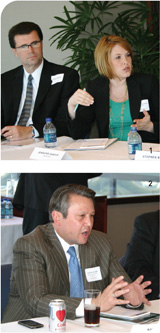
1: Doug Reagan heard Jennifer Shafer's take on how associates were learning quickly about the value proposition for clients. | 2: Ken McClain argued that the firms accounting for most of the court time should have to pay more, given the benefits they receive.
“I think partners and associates alike are beginning to realize that it’s not just a job,” added Mark Hinderks. Attorneys today have to invest in their own career. They have to make sure they are trained in an economically viable specialty. They have to build up, over time, the client relationships that will ultimately pay off, and all of this has to start early. “We’re preaching this to our associates the minute they’re in the door,” said Hinderks.
“Associates are learning faster about the value proposition clients are demanding,” said Jennifer Shafer of Warden Grier. They are no longer sitting in the background doing research. “They actually see the value
of what they’re doing, not only for their own business model they’re building, but for their clients.”
At King Hershey, a relatively small firm, Roxsen Koch observed that associates have always had the opportunity to get involved in significant work early in their careers. “It’s encouraging to hear that this is happening more at the big firms.
“In a small firm,” Shafer agreed, “that happens naturally, but what I think we’re seeing is that it’s happening faster, and the appreciation level goes up faster.”
For all the pressures of the economy, Ben Mann believes that this generation of associates is a little different, in part because the ability to make partner is not as guaranteed as it once was. Like Pete Smith, he saw the value in recruiting the best and brightest young attorneys his firm could find and accommodating their legitimate lifestyle needs, motherhood most notably. “So you really have to be, and we are, and we’re going to continue to be, adaptive and responsive to those kinds of requests.”
Technology and the Courts
Pete Smith raised the issue of the courts and their resistance to modernization. “I keep wondering,” said Smith, “when the hell are the courts going to catch up.” The problem, as he sees it, is that the courts’ refusal to adopt new technology leads to huge inefficiencies in time for attorneys and added costs to clients.
“There are three or four lawyers driving to the courthouse, waiting, having a hearing, coming back—because the courts are way behind in the advancement of the legal business/profession,” Smith said. So much of this work could be done through videoconferencing, he argued. “The technology is there; we’re not talking about the future.”
As Scott Kreamer noted, the problem is compounded by a lack of money to implement new technology. In the way of example, Kansas courts are now shut down on Fridays to help address the state’s budget crisis.
“There ought to be rules,” said Ken McClain, “that, to the extent that technology exists, [courts] ought to have to use it.” He gave the example of how much time and money could be saved if a 10-minute hearing in Joplin could be managed through videoconferencing. McClain has even suggested that the firms that are filing the cases be taxed to pay for the upgrade costs. “It should not be off-limits that those who are receiving the benefits pay more.”
Greg Goheen said he had recently participated in his first judicial videoconference and was pleased with the outcome. Not every firm would be able to afford the technology, he noted, but if it were available through a nearby courthouse, attorneys would have the ability to access it.
“Technology is cheap,” said Smith. He cited Newton’s First Law of Motion to explain a reluctance to change on the part of the court system: a body at rest stays at rest unless acted upon by an external force.
Pat Woolley, a patent lawyer, observed that the patent office was one of the few in government that worked electronically and demanded efficiency—and, by the way, actually generated revenue. “They don’t want to see you,” he noted. “They want you to be very efficient.”
Herb Kohn hoped, but without much confidence, that technology would provide a solution to a problem that has existed since he was a young attorney, namely, the courts’ historic indifference to lawyers’ time and clients’ money. “When I was a young lawyer I actually tried lawsuits,” he said, “and the main reason I stopped doing it was because I was embarrassed by our system. I was embarrassed to have clients or witnesses show up . . . and be told, ‘Come back in six weeks.’ ”
Craig O’Dear attributed much of the problem with the courts to the judicial equivalent of “pilot error.” He does not believe the system will produce better justice until it appoints better judges